|
Article I: Repairs Planned for OWEF Steam Line
Article II: Individuals and Businesses Recognized for Environmental Achievements
Article III: Composting in the Kitchen
Article IV: Disposal Discussion: Mercury
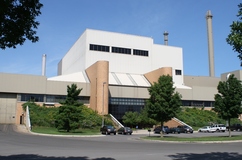
Unlike other plants that burn coal or natural gas, the Olmsted Waste-to-Energy Facility (OWEF) burns residents' garbage to create steam.
This steam passes through turbine generators at the OWEF to create electricity. Additionally, the steam is used to heat and cool buildings on the Olmsted County District Energy System (DES). Nearly two miles of pipe—most of which is buried underneath 4th Street SE in Rochester—connect the Olmsted Waste-to-Energy Facility to buildings on the western end of the DES. These buildings include the Olmsted County Government Center, Work Release Center, Rochester City Hall, Rochester Public Library, Rochester Art Center, and Mayo Civic Center.
|

If you've driven down 4th Street SE lately, you may have noticed plumes of steam coming from manholes at the following intersections:
- 4th Street SE / 6th Avenue SE
- 4th Street SE / 11th Avenue SE
- 4th Street SE / 13th Avenue SE
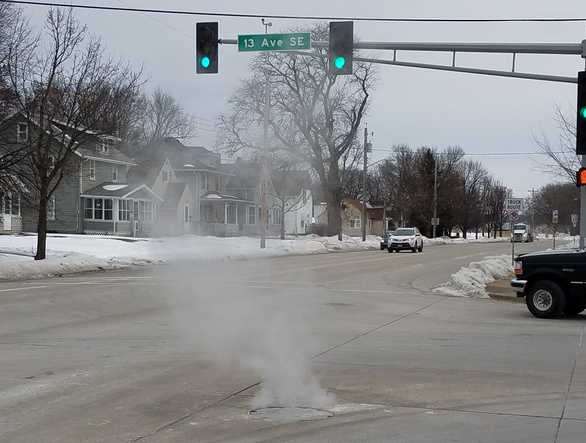 Steam rises from the manhole at the intersection of 4th Street SE and 13th Avenue SE; photo credit: Anthony Wittmer
Last November, leaks were discovered outside of the vaults (accessible manholes intended to service the system) at various locations along the steam line. Water has been able to seep into the vaults and come in contact with the 307°F steam line, causing steam to rise out of the manhole covers. The plumes are especially noticeable on cold days.
The steam/condensate lines are still functional but repairs are necessary. Fixing the leaks will require a temporary shut-down of the system starting at Campus Drive.
Work on the system is expected to begin this May but an official start date has not yet been set. The repairs will be scheduled when weather is more moderate to limit the inconvenience to DES customers. More information (road closures, project duration, etc.) will be released as details become available. In the meantime, the system is being monitored and maintained regularly to ensure continuity of service and to meet safety standards. Questions should be directed to the Environmental Resources Department at pwservice@co.olmsted.mn.us or 507-328-7070.
The Olmsted County Environmental Commission and Rochester Public Utilities (RPU) recognized the winners of the 2018 Environmental Achievement Awards at a banquet on Thursday, January 17, 2019.
The awards program honors individuals, organizations, schools, and businesses that have made a significant contribution to environmental quality in Olmsted County. More information about the awards program can be found on the Environmental Resources website.
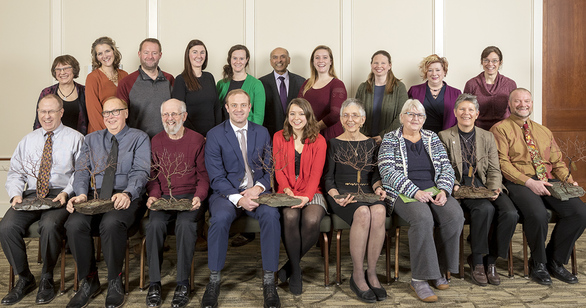 2018 Environmental Achievement Award winners and nominators; photo credit: Josh Banks of BanksPhotos.com
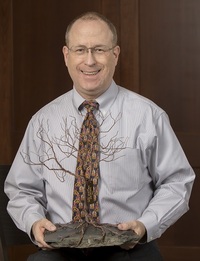
2018 Award Winners
Keith Anderson
Nominated by Sandy Bauter
The Monarch butterfly is easy to spot with its wings of bright orange, black, and white polka dots. Every fall, these amazing creatures embark on a journey that extends over 2,000 miles, migrating from their home range in Canada and the United States to the forests of Central Mexico. More than just a pretty sight, these insects contribute to the environmental health of our planet by pollinating plants along the way. Unfortunately, populations have been in serious decline as a result of habitat loss and a changing climate.
Keith Anderson is trying to change that. One day in the spring of 2017, he saw a monarch lay an egg. With his curiosity piqued, he went looking for and found about a dozen monarch caterpillars. The next day, all of them were gone. This motivated him to begin raising the butterflies indoors. Since that day, Keith has raised over 1,000 butterflies from the eggs found in his yard alone. He has shared chrysalises with Quarry Hill Nature Center, the MN Master Naturalists, and local schools. His work is inspiring others in the community to raise and release butterflies of their own.
|
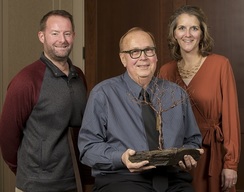
Lincoln K-8 Faculty Beekeepers
Nominated by Jim Sonju
Honey bees are all-star pollinators. The U.S. Department of Agriculture claims that managed colonies add at least $15 billion of value to U.S. agriculture annually through increased yields and quality harvests. With the overall health of the species in question, faculty members at Lincoln K-8 District-Wide School found a way to introduce their students to these amazing insects.
In May of 2018, the school purchased a Flow™ Hive and built a foundation for it to sit on. This style of hive allows the students to see what’s going on inside the hive without disturbing it. The school worked with the Boy Scouts of America to locate the hive at the Gamehaven Council Headquarters. Doing so provided more space for the bees and ensured the hive wouldn’t get hit by an errant playground pass. Additionally, the University of Minnesota Extension was crucial to the project’s success in educating the teachers on how to properly care for the bees. The school’s hive will serve as an active learning opportunity for many classes to come, fostering an appreciation, rather than a fear of bees.
Pictured in photo: Jason Howes, James Kulzer, Beth Napton
|
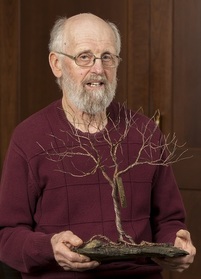
Curt Tvedt
Nominated by Shona Snater
Curt Tvedt is a life-long learner with a passion for soil health. He has been incorporating conservation practices since he began farming decades ago, but as of 2015, Curt has learned that we can build soil back relatively quickly through no-tilling and cover cropping. For the past three years, Curt has planted soybeans into living rye in the spring and later crimped the rye to provide a mat of residue for the soybeans to grow through. This protects the soil from heavy rains and naturally suppresses weed growth. Eventually, he would like to increase his soil health to the point of not needing as many inputs (labor, fuel, fertilizer, etc.).
Curt has started peer-to-peer education groups to promote conservation farming. As a member of the Land Stewardship Project—an organization that promotes sustainable farming—he has hosted field-days to share his successes through presentations and demonstrations. Additionally, he has taken courses in microbiology to better understand processes that build organic matter back into the soil.
|
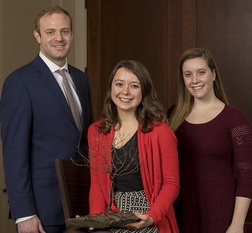
Sierra Student Coalition at UMR
Nominated by Joe Marchesani
The Sierra Student Coalition (SSC) at the University of Minnesota Rochester (UMR) believes that through teamwork and creative collaboration, citizens can contribute to scientific discovery and the advancement of a local policy designed to protect people and the environment. In March 2017, the SSC began collaborating with the following organizations to develop a community-driven air quality study:
- Rochester Sierra Club
- Rochester Energy Commission
- RNeighbors Association
- Zumbro Valley Medical Society
- Minnesota Pollution Control Agency
- Pediatric Asthma Epidemiology Research Unit
- Fresh Energy Board
- UMR Faculty and Staff
The Rochester Air Quality Feasibility Project was modeled after an air quality study conducted by faculty at the University of Iowa (UI). SSC students talked extensively with the creators of the UI study and took their experiences into account when deciding research methods, materials, and the study’s structure. With the help of volunteers, the SSC collected air samples at multiple locations across Rochester in August and December of 2017. In 2018, SSC students worked with local physicians to analyze the data.
The Rochester Air Quality Feasibility Project found that levels of particulate matter in the air can vary considerably across neighborhoods in Rochester. The study provided preliminary data that supports the addition of more air monitors in town.
Pictured in photo: Matt Spiten, Cassie Zell, Lis Pearson
|
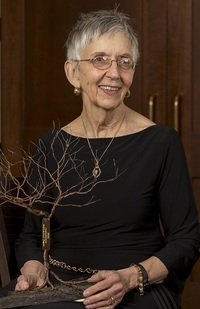
De Cansler
Nominated by Alissa Naymark
“People protect what they love, they love what they understand, and they understand what they are taught.” These words from Jacques-Yves Cousteau stuck with De Cansler throughout her teaching career and beyond. For many years, De used monarch butteries donated by the University of Minnesota Monarch Lab, as a focal organism in her middle school science classes. The students were able to literally watch science come to life as the butterflies progressed through their life cycle’s various stages. In 2006, she furthered her monarch expertise by spending a year-long sabbatical in the U of M’s Monarch Lab. The knowledge she gained through the experience proved especially valuable once the Monarch Lab stopped distributing eggs and larvae to classrooms in 2008.
De began breeding and raising her own monarchs. She retired from teaching in 2010, but her work with the butterflies continued. De has delivered countless eggs, larvae, and chrysalises to schools and organizations across Southeastern Minnesota at no charge. She has also shared her knowledge with teachers across the country. Thanks to her work, thousands of students have a better understanding of the natural world around them.
|
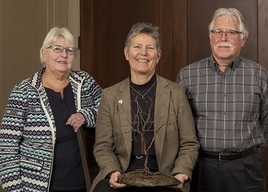
Homestead Trails Neighborhood Association
Nominated by Rene Halasy
In 2010, the Homestead Trails Neighborhood Association worked with the Rochester Parks and Recreation Department to establish a policy that allowed residents to plant vegetable and flower gardens on parkland and/or public lands. Once permission was granted for their garden, the neighbors began work clearing a lot at the junction of King Court SE and Neville Court SE in Rochester. The site had previously been used as on old construction dump site and was filled with concrete slabs, broken asphalt, old pipes, and more. The neighborhood received multiple RNeighbors Project Grants to rent equipment heavy enough to remove the debris. Fresh dirt and compost were brought in to improve soil fertility which allowed the neighbors to begin plans of establishing a community garden.
An average of 35 neighbors help with the garden each year and an estimated 55 individuals have been involved in the work since the project began. With time, sweat, and patience, the Homestead Trails Neighborhood Association transformed this piece of land from a waste site into a thriving food source and gathering space.
Key accomplishments:
• The lot’s soil fertility was restored.
• At least 25 homes now have access to fresh veggies four months of the year.
• Planting trees and restoring native grasses/flowers reduces stormwater runoff.
• Native flowers bloom around the garden and attract pollinators.
Pictured in photo: Dee Schemmel, April Sutor, Hal Rowe
|
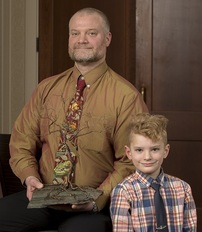
Andrew Pruett
Nominated by Jill Danielsen
Andrew Pruett’s connection to Quarry Hill Nature Center goes back almost thirty years. At twelve years old, he would ride his bike to the Nature Center to help feed the animals. As a senior in high school, he cleared buckthorn from Quarry Hill Park’s oak savanna. These days, Andrew volunteers as a beekeeper and cares for the captive animals.
His passion for honey bees stemmed from his father, who kept bees and received subscriptions to the American Bee Journal—Andrew remembers reading copies cover to cover. Years later, his passion was reinforced by his future wife, an experienced beekeeper and former Wisconsin Honey Queen. For the last eight years, Andrew has overseen bee care at Quarry Hill Nature Center. He feeds the bees, regularly checks on the queen, and monitors the overall health of the colony. Andrew also keeps three hives on his own property to supplement Quarry Hill’s hive if the population drops.
Since 2016, Andrew has helped care for the Nature Center’s captive animals. He has researched every animal in his care and readily shares his knowledge with the public. Andrew hopes his efforts will inspire the next generation to appreciate wildlife as much as he does.
Pictured in photo: Andrew Pruett (with his son, Theodore)
|
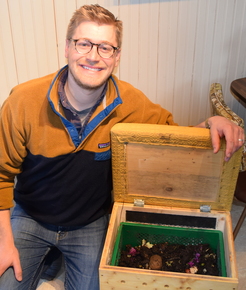
When Aaron and Kylie Gamm got married last summer, they received an unusual wedding gift from their friends visiting from Austria—a bag of worms and a compost box disguised as a stool.
Vermicomposting is the process of using worms to decompose organic waste. And while most would consider this an activity better suited for a backyard compost bin, the Gamms were quick to integrate their new "worm box" into their kitchen.
"The whole thing came in a kit, so it was pretty easy to get started," said Aaron. He also said that most people wouldn't know what it was if the Gamms didn't tell them. "It doesn't smell at all. We have had visitors use it as another chair and were none the wiser until they had to stand up so we could scrape our plates into it."
Both Aaron and Kylie are health-conscious people, so the box gets used frequently, "We cook with a lot of vegetables, so it seems like we are always throwing stuff in it," said Aaron. Maintaining the box is pretty simple. The couple mixes the compost occasionally, adds a teaspoon of minerals for the worms each month, and empties a tray in the bottom of the box that collects worm leachate (water that passes through the compost). The Gamms dilute the leachate and use it as fertilizer for their houseplants. As an added benefit, the pair estimates their compost box will help them help keep 75-100 lbs. of organic waste out of their garbage each year.
The couple understands that composting indoors may not be for everyone, but said it's more common than you might think. Residents interested in getting started should check out these how-to instructions from the Minnesota Pollution Control Agency.
|
 Aaron and Kylie Gamm pictured with their kitchen compost box: photo credit, Aaron Gamm
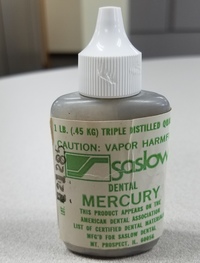
Mercury is a naturally-occurring element. Evidence of its use, or rather misuse, can be traced back throughout history. It's believed that the first emperor of China, Qin Shi Huang, would eat mercury sulfide (cinnabar) in an attempt to attain immortality. As recent as the early 1900s, mercury-containing products were touted as remedies for a variety of medical ailments, ranging from syphilis to teething pain.
These days, mercury's impact on human health is well-documented, making its early uses seem all the more ironic. The Environmental Protection Agency (EPA) sites mercury as a neurotoxin and outlines a long list of health concerns attributed to mercury exposure.
While mercury's use in products has been rapidly phased out, it can still be found in the following household items:
- Barometers (non-digital)
- Button batteries and mercuric oxide batteries
- Fluorescent light bulbs, compact fluorescent light bulbs (CFLs), high-intensity discharge (HID) lamps, and neon lights
- Thermometers (non-digital)
- Thermostats (non-digital)
Visit the EPA's website for a longer list of items containing mercury.
Mercury products should never be thrown in a garbage or recycling bin. In Olmsted County, residents can dispose of mercury products correctly by bringing them to the Hazardous Waste Facility (HWF). Proper disposal protects waste handlers, other waste disposal facilities (Recycling Center Plus, Waste-to-Energy Facility, etc.), and the environment from contamination. Over the last few decades, the HWF has collected nearly 2,800 lbs. of mercury!
|
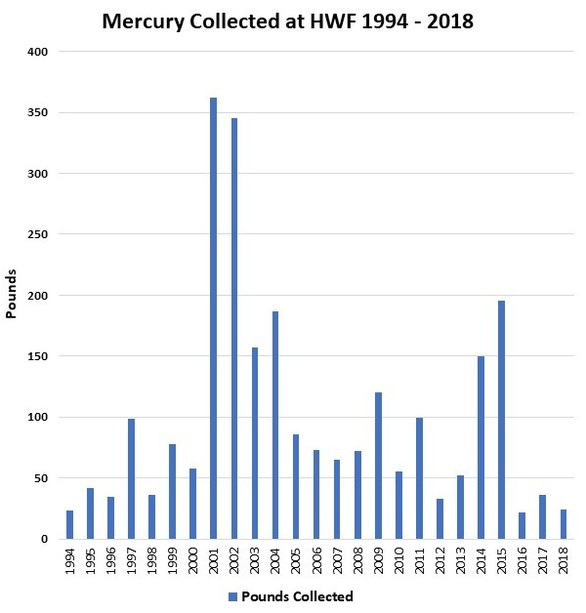
|